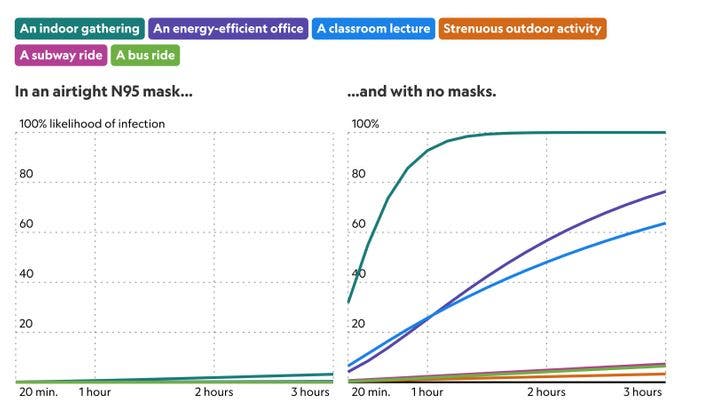In the first weeks of the pandemic, the word ‘droplets’ seemed ubiquitous. It spreads through droplets. It’s the droplets that pass a virus. There’s a difference between droplet and airborne transmission and the initial trials seemed to suggest that we were dealing with the former, not the latter.
But recent studies are starting to tell a different story.

What airborne means
The current scientific consensus is that SARS-CoV-2, the novel coronavirus causing a pandemic, is mostly spread through droplets: tiny globs of mucus or saliva propelled from people’s noses or mouth when they cough, sneeze, or even just talk.
When droplets become really small (diameter of 5μm or less) and become suspended in the air, they’re called aerosols — and this is a key difference. Due to their small size, aerosols can stay suspended for longer periods of time (even a few hours) and can travel further than large droplets.
A virus that can spread via aerosols (like measles, for instance) is considered airborne, while SARS-CoV-2 is not airborne — or so we thought, initially. More and more, studies are starting to suggest that airborne transmission could be a possibility.
For instance, one recent study used laser light scattering to detect droplets as people talked, finding that droplets as small as 4μm were produced. This information, coupled with another study that found that small droplets can remain infectious for up to 16 hours, seems to back the idea of airborne transmission. However, the World Health Organization argued that this doesn’t “reflect normal human cough conditions”.
The airborne debate remained suspended in the air, until studies actually found coronavirus suspended in the air.
A smoking gun

Studies pointing at airborne transmission were already starting to add up; one such study in Wuhan, where the pandemic emerged, found coronavirus genetic material in samples from two hospitals, but it wasn’t clear if the virus was still infectious. In another study from China, families eating at a restaurant all became infected despite having no contact with each other and staying several meters apart.
But a smoking gun was missing, until recently.
In a new study, researchers have found evidence of SARS-CoV-2 suspended airborne in a hospital room with COVID-19 patients. The virus was still active, as researchers managed to culture it from air samples. Although the study has not yet been peer-reviewed, this is a clear smoking gun, says Linsey Marr, an expert in airborne spread of viruses who was not involved in the work. In a separate Tweet, Marr also said the WHO is still in denial about airborne transmission.
After a growing mass of studies hinted at airborne transmission, 239 scientists published a commentary in Clinical Infectious Diseases calling for the recognition of airborne transmission for COVID-19.
What does this mean?
By now, airborne transmission seems more than just a possibility — it’s happening. We still don’t know how often it happens or how important the role of airborne transmission is for the pandemic. But here’s the thing: the airborne/droplet difference is not a fixed line where it’s either one or another. A sneeze or cough (or even just speech) can create a swarm of droplets in many different size ranges, some of which could remain suspended in the air for a longer period of time.
The problem is that figuring out what size of droplets causes most of the disease transmission is an extremely challenging task. Basically, it could be a long time before we figure out just how important airborne transmission is in this case.
“Even for the flu, which we’ve studied for decades, we still don’t know how much is transmitted by aerosols or by touching contaminated objects,” Marr says.
For our day to day life, this suggests that social distancing alone might not be enough to stop the spread of disease. Whether it’s one meter, 2 meters, or 6 feet, most nations made some recommendation giving people a sense of security if they are beyond a specific distance — that sense might not be fully warranted. The findings also push for more precautions regarding ventilation.
The virus seems to spread through air. We don’t know how often it happens, but it’s one more thing we need to consider and adjust accordingly.









